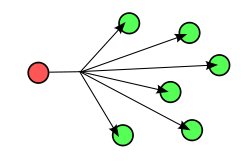- Broadcasting (computing)
-
Not to be confused with Broadcasting.
In telecommunication and information theory, broadcasting refers to a method of transferring a message to all recipients simultaneously. Broadcasting can be performed as a high level operation in a program, for example broadcasting Message Passing Interface, or it may be a low level networking operation, for example broadcasting on Ethernet.
Contents
Overview
Routing schemes
broadcast
In computer networking, broadcasting refers to transmitting a packet that will be received by every device on the network[1]. In practice, the scope of the broadcast is limited to a broadcast domain. Broadcast a message is in contrast to unicast addressing in which a host sends datagrams to another single host identified by a unique IP address.
Not all network technologies support broadcast addressing; for example, neither X.25 nor frame relay have broadcast capability, nor is there any form of Internet-wide broadcast. Broadcasting is largely confined to local area network (LAN) technologies, most notably Ethernet and token ring, where the performance impact of broadcasting is not as large as it would be in a wide area network.
The successor to Internet Protocol Version 4 (IPv4), IPv6 also does not implement the broadcast method to prevent disturbing all nodes in a network when only a few may be interested in a particular service. Instead it relies on multicast addressing a conceptually similar one-to-many routing methodology. However, multicasting limits the pool of receivers to those that join a specific multicast receiver group.
Both Ethernet and IPv4 use an all-ones broadcast address to indicate a broadcast packet. Token Ring uses a special value in the IEEE 802.2 control field.
Broadcasting may be abused to perform a DoS-attack. The attacker sends fake ping request with the source IP-address of the victim computer. The victim computer is flooded by the replies from all computers in the domain.
See also
References
External links
Categories:- Packets (information technology)
Wikimedia Foundation. 2010.







